Princess Louise of Denmark (1750–1831)
Last updated| Princess Louise | |
|---|---|
| Princess Charles of Hesse-Kassel | |
 Pastel by Jean-Baptiste Perronneau | |
| Born | 20 January 1750 Christiansborg Castle, Copenhagen |
| Died | 12 January 1831 (aged 80) Gottorp Castle, Schleswig |
| Burial | |
| Spouse | |
| Issue | Marie, Queen of Denmark and Norway Prince Frederick Prince Christian Louise Caroline, Duchess of Schleswig-Holstein-Sonderburg-Glücksburg |
| House | Oldenburg |
| Father | Frederik V of Denmark |
| Mother | Princess Louise of Great Britain |
Princess Louise of Denmark and Norway (Danish : Louise af Danmark; Norwegian : Louise av Danmark) (20 January 1750 – 12 January 1831) was born to Frederick V of Denmark and Louise of Great Britain. [1] Her eldest daughter, Marie of Hesse-Kassel, was the wife of Frederick VI of Denmark.
Contents
Life
Early life

Princess Louise was born on 20 January 1750 at Christiansborg Palace, the principal residence of the Danish Monarchy in central Copenhagen. [2] She was a daughter to Frederick V, King of Denmark and Norway, and his first wife Louise of Great Britain. [2] At birth, Louise had two older sisters, Princess Sophia Magdalena and Princess Wilhelmina Caroline, and an older brother Crown Prince Christian. In 1751, one year after Louise's birth, her mother Queen Louise died during her sixth pregnancy, just aged 27 years. [3] The following year her father remarried to Duchess Juliana Maria of Brunswick-Wolfenbüttel, who gave birth to Louise's half-brother, Prince Frederick in 1753. [4]
Princess Louise was considered the most beautiful and spirited of Frederick V's children, but also the most reserved. [5] She was Christian VII's favorite sister, and he was already from childhood strongly attached to his "Louison," as he called her. [5] [6]
Marriage

In 1756, Queen Louise's sister, Mary, who was estranged from her husband, Landgrave Frederick II of Hesse-Kassel, moved to Denmark to take care of her deceased sister's children. She brought her three sons with her, who were brought up at the Danish court with their Danish cousins. On 30 August 1766 at the Christiansborg Palace Chapel, Louise married the second eldest of them, Landgrave Charles of Hesse-Kassel. [7] The marriage took place with her brother King Christian VII's consent, despite advice given against it, due to many accusations of debauchery by Landgrave Charles and the poor influence he had on the King. [1] This, however, did not last, as Christian VII's warm feelings for him soon evaporated, and in the spring 1767, the couple left Copenhagen to live in Hanau. [8]
Later life
She would have her first child in Hanau, Marie Sophie, Princess of Hesse on 20 October 1767 and then her second, Wilhelm, Prince of Hesse on 20 January 1769. The family would then move to Gottorp Castle after her spouse was appointed governor of Schleswig Holstein. In 1770, King Christian VII gave his sister a parish and land in Güby, Schleswig-Holstein, which was named Louisenlund in her honour. In the summer of 1770, Louise and Charles hosted the king and queen during their tour of the Duchies on their way to the German border. [9] During their stay, rumors circulated about the affair between the queen and Struensee because of their manner, and it was observed that the queen was anxious not to be near Struensee in the presence of Louise. [9] When the royal couple left, Louise was reportedly disappointed that she was not asked to accompany them on their journey. [9] She would have her third child Prince Frederik of Hesse on 24 May 1771. [1]
After the removal and execution of Johann Friedrich Struensee on 28 April 1772 her husband found favour with the King again and with it, he was appointed commander-in-chief of the Norwegian army. in September 1772. It was said that Charles planned to raise support in Norway for a coup to take the regency power over the king from prince Frederick and queen dowager Juliana. [10] Louise did not initially accompany him there, but when he returned to Denmark in April 1773, she returned with him to Norway in June. They were very well received in Christiania, and upon their arrival in Trondhjem, one aristocrat, Nordahl Brun, welcomed them as the "heavenly couple", and greeted Louise with a poem. [11] In the Landgrave's own words, he became so popular that the Norwegians would gladly have him as King. This was clearly an illusion, and the people of Christiania soon found the cost of constantly entertaining the couple, a huge burden on town expenses. [8] Expensive demands, such as new golden chairs to sit in during church service, and a triumphal arch for the official entry of Louise in to Christiania where examples of the standard the royal couple demanded for their standard during their stay and created antipathy among the population. [12] On 4 September, Louise and Charles hosted a ball and a court reception in honor of the birthday of queen Juliana Maria and departed on 8 September 1773. [13]
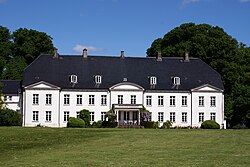
With her husband's larger income, he had Hermann von Motz build Louisenlund Castle on the land in Güby as a summer residence for the couple. The Princess would have her fourth child Juliane, Princess of Hesse on 19 January 1773 before leaving Norway and moving into Louisenlund Castle in 1774. Her husband was also made Field Marshal the same year but would stay away from political circles and remain at Louisenlund till the 14th change of government in April 1784. The new change brought a close friendship with Crown Prince Frederik, who would also marry their daughter Princess, Marie Sophie. [8] They would later become King Frederick VI of Denmark and Queen Marie Sophie of Denmark.
Princess Louise would have two more children, Prince Christian of Hesse, born 14 August 1776 and Princess Louise Caroline of Hesse-Kassel, born 28 September 1789. Her husband continued as commander-in-chief of the Norwegian army until 1814 and governor of Schleswig Holstein all her life. She died at Gottorp Castle on 12 January 1831 and was buried in Schleswig Cathedral. [1]
Ancestry
| Ancestors of Princess Louise of Denmark (1750–1831) [14] |
|---|
Children
She had 6 children together with her husband, they are:
- Marie Sophie, Princess of Hesse (20 October 1767 – 21 March 1852), married on 31 July 1790 to the future King Frederik VI of Denmark and Norway
- Wilhelm, Prince of Hesse (15 January 1769 – 14 July 1772)
- Prince Frederik of Hesse (24 May 1771 – 24 February 1845)
- Juliane, Princess of Hesse (19 January 1773 – 11 March 1860), Protestant Abbess of Itzehoe
- Prince Christian of Hesse (14 August 1776 – 14 November 1814)
- Princess Louise Caroline of Hesse-Kassel (28 September 1789 – 13 March 1867), married on 28 January 1810 to Friedrich Wilhelm, Duke of Schleswig-Holstein-Sonderburg-Glücksburg
Related Research Articles

Christian VII was a monarch of the House of Oldenburg who was King of Denmark–Norway and Duke of Schleswig and Holstein from 1766 until his death in 1808. For his motto he chose: "Gloria ex amore patriae".

Christian VIII was King of Denmark from 1839 to 1848 and, as Christian Frederick, King of Norway in 1814.

Frederick VIII was King of Denmark from 29 January 1906 until his death in 1912.
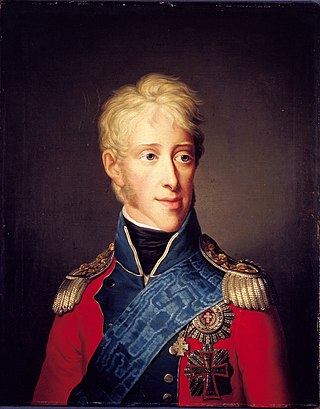
Frederick VI was King of Denmark from 13 March 1808 to 3 December 1839 and King of Norway from 13 March 1808 to 7 February 1814, making him the last king of Denmark–Norway. From 1784 until his accession, he served as regent during his father's mental illness and was referred to as the "Crown Prince Regent". For his motto he chose God and the just cause and since the time of his reign, succeeding Danish monarchs have also chosen mottos in the Danish language rather than the formerly customary Latin. As Frederick VI had no surviving sons to succeed him, he was succeeded on the throne of Denmark by his half-first cousin Christian, who was his father's half-brother's son.

Frederick IV was King of Denmark and Norway from 1699 until his death. Frederick was the son of Christian V of Denmark-Norway and his wife Charlotte Amalie of Hesse-Kassel.

Frederick V was King of Denmark–Norway and Duke of Schleswig-Holstein from 6 August 1746 until his death in 1766. He was the son of Christian VI of Denmark and Sophie Magdalene of Brandenburg-Kulmbach.

Louise of Hesse-Kassel was Queen of Denmark as the wife of King Christian IX from 15 November 1863 until her death in 1898.

Marie Sophie Frederikke of Hesse-Kassel was Queen of Denmark and Norway by marriage to Frederick VI. She served as regent of Denmark during the absence of her spouse in 1814–1815.

Frederick, Hereditary Prince of Denmark was heir presumptive to the thrones of Denmark and Norway. He was the only surviving son of King Frederick V by his second wife, Juliana Maria of Braunschweig-Wolfenbüttel.
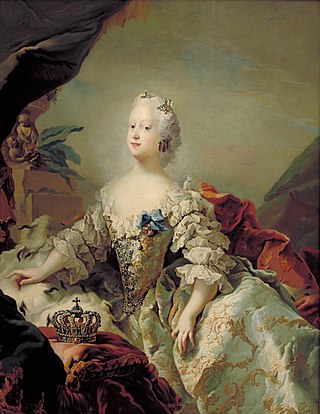
Louise of Great Britain was Queen of Denmark and Norway from 1746 until her death, as the first wife of King Frederick V. She was the youngest surviving daughter of King George II of Great Britain and Caroline of Ansbach.

Princess Louise Augusta of Denmark and Norway was the daughter of the Queen of Denmark-Norway, Caroline Matilda of Great Britain. Though officially regarded as the daughter of King Christian VII, it is widely accepted that her biological father was Johann Friedrich Struensee, the king's royal physician and de facto regent of the country at the time of her birth. She was referred to sometimes as "la petite Struensee"; this did not, however, have any effect on her position.

Prince Charles of Hesse-Kassel was a cadet member of the house of Hesse-Kassel and a Danish general field marshal. Brought up with relatives at the Danish court, he spent most of his life in Denmark, serving as royal governor of the twin duchies of Schleswig-Holstein from 1769 to 1836 and commander-in-chief of the Norwegian army from 1772 to 1814.

Princess Louise Charlotte of Denmark was a Danish princess, and a princess of Hesse-Kassel by marriage to Prince William of Hesse-Kassel.

Stiftung Louisenlund is a privately run boarding school for boys and girls in Güby, Schleswig-Holstein, Germany.

Princess Wilhelmina Caroline of Denmark and Norway, was the Landgravine consort of Hesse-Kassel and later the Electress of Hesse-Kassel by marriage to William I, Elector of Hesse.
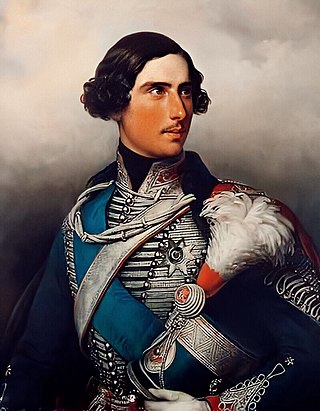
Frederick William George Adolphus, Landgrave of Hesse was the only son of Wilhelm I, Landgrave of Hesse-Kassel-Rumpenheim and Princess Louise Charlotte of Denmark.

Prince Frederik of Hesse, Landgrave Friedrich of Hesse-Cassel was a Danish-German nobleman, general and Governor-general of Norway (1810–1813) and the same in the duchies of Schleswig and Holstein (1836–1842).

Hans Henrik Rode was a Norwegian military officer.
Prince Christian of Hesse was a German prince and member of the House of Hesse-Kassel. As a son of the Danish Field Marshal Prince Charles of Hesse-Kassel and Princess Louise of Denmark, he was a member of the extended Danish Royal Family and spent his entire life in Denmark.
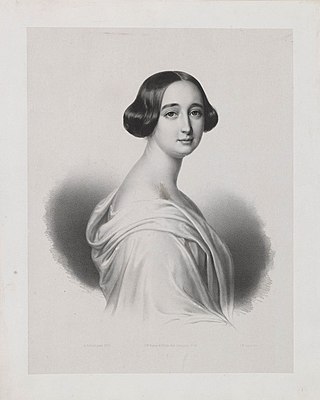
Auguste Sophie Friederike Marie Caroline Julie of Hesse-Kassel, known as Princess Augusta, was a Princess of Hesse-Cassel, a daughter of Prince William of Hesse-Kassel (1787–1867) and Princess Charlotte of Denmark (1789-1864). She spend most of her life in Denmark.
References
Citations
- 1 2 3 4 Bricka, Carl Frederik (1887). DANSK BIOGRAFISK LEXIKON (in Danish) (X. Bind. Laale - Løvenørn ed.). Copenhagen: Gyldendalske Boghandels Forlag (F. Hegel & Søn). p. 402. Retrieved November 19, 2009.
- 1 2 Hiort-Lorenzen 1896, p. 402.
- ↑ "Louise af Storbritannien". gravsted.dk (in Danish). Retrieved 21 January 2022.